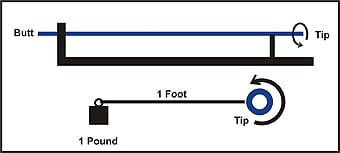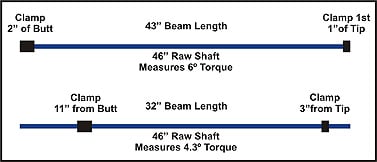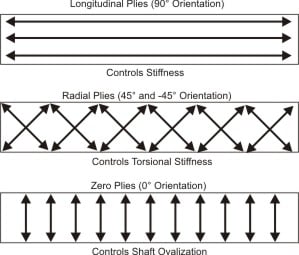What Is Shaft Torque?
Torque is the simply the amount a golf shaft (shown in blue) twists when subjected to a known amount of force (usually one foot-pound of force is applied) and the torque value is always expressed in degrees. It is a term commonly associated with composite or graphite shafts, but steel shafts have a certain degree of torque too. However the amount cannot be independently changed from the frequency (or stiffness) of the shaft like a composite design, thus torque of steel shafts is generally not listed by the manufacturer. A lower torque value (i.e. 3.5° versus 4.5°) resists the shaft from twisting on the downswing with all else equal.

Is there a standard measure for shaft torque in the golf industry?
The answer to that is no, just like most parameters in the golf industry. I like to say “the only standard in the golf industry is there are no standards.” Each manufacturer has an internal method for measuring torque that will vary from one to the next. However, each shaft by the manufacturer will be measured using the exact same clamping dimensions and force for all their shafts. To explain this, let’s look at the following diagram.

The top shaft shows how Hireko measures torque for our Dynamic Shaft Fitting Index. We clamp 1” of the tip where the tip weight or force is applied. Of course for this to occur, the butt end is clamped (in our case 2”) to secure the shaft. The difference between the clamps is called the beam length. At Hireko, we measure a longer beam length than any manufacturer which is important to know when looking at out listed values versus those by the actual manufacturer.
For the sake of example, this 46” raw shaft (with a 43” beam length) happens to measure a torque of 6.0º using 1 foot-pound of force. By most standards, this torque rating may seem high.
Now let’s take the same exact shaft and change the clamping dimensions. Some manufacturers may elect to clamp 3” up from the tip and use a 32” beam length on their woods. This means the butt end of the shaft is clamped 11”. While this may sound like a lot of shaft is not being included for the torque measurement, there may be a valid reason. Some manufacturers have been measuring torque on their shafts since the days when wooden woods were common. In those days the shaft would exit the head 3” from the tip. Plus the shaft would be cut to length and not used at its full length. The clamping dimension further down the butt end would be closely associated with the position of the lower hand or portion of the grip.
By changing the beam length, the torque value of this shaft goes from 6.0º down to 4.3º, which is no longer considered high, but more average for a wood shaft. None of the manufacturers that I am aware of show how their torque is measured. So comparing torque values from manufacturer to manufacturer is not an exact science like it is by looking at the values from shaft-to-shaft with one particular company’s product line. This is one of the reasons why Hireko continues to test all parameters using the same testing methods and publish those results in our annual Shaft Fitting Addendum.
Is lower torque golf shaft better?
The one thing about torque is that it is perhaps the most misunderstood shaft parameter and to the bewilderment of many, may not make complete sense. There is a myth out there that the lower the torque the better and will result into a straighter shot. While that may had started in the early days of graphite production, this is not entirely true today.
One of the reasons shafts with higher torque values are considered less accurate can be attributed to the cost. Often times the higher torque wood shafts (above 6°) will be less than $9 retail and may not be 100% graphite, but have a certain percentage of fiberglass mixed in. One clue is to look at the shaft weight. A heavier weight will be a sure sign that is contains a high percentage of fiberglass. Some shafts that are found in boxed sets or very inexpensive composite shafts contain fiberglass.
Low cost graphite shaft are constructed with low modulus (lower strength) materials. Often times these shafts will exhibit both high torque and a softer tip section. In the hands of a stronger player, this combination would be less accurate than a lower torque model.
 But not all higher torque shaft use low modulus material. Contrary, some of the world’s most expensive shafts have higher torque values and here are a couple reasons why. With the advent of 4-axis winding, manufacturers might elect to wrap high modulus graphite plies at 0° angles on the mandrel to increase the hoop strength and control shaft ovalization allowing for better shot consistency. These fibers have no contribution to the torque of the shaft.
But not all higher torque shaft use low modulus material. Contrary, some of the world’s most expensive shafts have higher torque values and here are a couple reasons why. With the advent of 4-axis winding, manufacturers might elect to wrap high modulus graphite plies at 0° angles on the mandrel to increase the hoop strength and control shaft ovalization allowing for better shot consistency. These fibers have no contribution to the torque of the shaft.
How does shaft weight affect shaft torque?
Secondly, shaft weight plays an important factor. If you do not believe me, look at any shaft line that is produced in different weight options. It should come as no surprise that the lighter the shaft; the higher the torque value. When you think about it, this makes complete sense. If less material is used (due to the lighter weight), there is less material available to control torque or resist twisting.
This year will there will be a focus or at least a trend toward lighter and lighter weight drivers. These drivers will be using shafts in the 50 gram and even lighter range. All of these super-lightweight shafts will require better quality materials to achieve the target weight and limit breakage. As a result of the thinner walls these shafts may have torque value by the manufacturer close to 6º (or 8º using Hireko’s longer beam length method), yet will produce highly playable clubs.
If you have control problems with these lighter weight / higher torque designs – don’t blame the torque. Blame the longer assembly length or the potential that the club is just too light for you to handle. Additional torque could actually be your friend, especially if you tend to fade, push or slice the ball as this could help to close the club face and not resist it.
